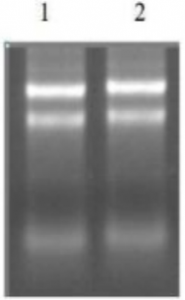Cat. No. ATB2700-50 50 mL
Cat. No. ATB2700-100 100mL
Store the kit at 2°C to 8°C
Description
TRIpure reagent can isolate total RNA from animal, plant, yeast, bacteria and virus samples. This reagent can preserve the
integrity of RNA during the cell lysis procedure. After adding chloroform and centrifugation, two layers form: the upper
hydrophilic phase contains the extracted RNA, the lower hydrophobic phase contains cell membrane, DNA, protein and other
cell debris. RNA in the upper phase can be precipitated with isopropanol. After removal of the upper phase, protein and
genomic DNA can also be isolated by precipitation (if wanted).
For most type of samples, TRIpure reagent can effectively isolate RNA from either small amount of sample (eg. 50-100 mg
tissue or as few as 5×10 cells), or large amount of sample ((eg. ≥1 g tissue or as many as 10 cells). The RNA isolation procedure
using TRIpure reagent is easy and time-efficient. Multiple samples can be processed at the same time. In most cases, the whole
procedure can be done within an hour. RNA isolated using TRIpure reagent contains almost no protein or genomic DNA
contamination, and is suitable for RT-PCR, Northern blot, dot blot, poly(A)+ selection and in vitro translation etc.
Features
Isolate RNA, DNA, and protein from the same sample Superior lysis capability, even with difficult sample types Optimized
formulations and protocols for tissues, cells, serum, virus, and bacteria
Storage
TRIpure Reagent is stable for 12 months at room temperature. For best results, store at 2~8°C is recommended.

Figure 1. RNA Extraction Comparasion From Mouse Liver
1. ATB Tri-Pure Reagent; 2. Invitrogen TRIzol Reagent.
RNA EXTRACTION PROCEDURE
Note: Wear gloves and safety glasses. Work with TRIpure Reagent in a fume hood. Avoid contact to skin and clothes. Avoid
vapors inhale .Handle every step in a fume hood at room temperature.
Materials Needed but not supplied:
1. Chloroform
2. Isopropyl alcohol
3. 75% ethanol (in DEPC-treated water)
4. RNase-free water or 0.5% SDS
Equipment and supplies:
1.Refrigerated centrifuge
2. Microcentrifuge
3. Micropipettors
4. Aerosol-barrier tips
5. Vortex mixer
6. Powder-free gloves
7. Centrifuge tubes
1. SAMPLES HOMOGENIZATION
a. Tissues:
Homogenize tissue samples in 0.75 ml of TRIpure reagent per 50 to 100 mg of tissue using a glass-Teflon or power
homogenizer. If tissue sample volume is less than 0.25ml, add autoclaved water to 0.25ml.
b. Cells grown in Monolayer:
Add 0.3-0.4 ml of TRIpure Reagent to a 3.5 cm diameter culture dish, pippet up and down to help lysis cells. Decide the
volume of TRIpure Reagent added according to dish area rather than cell number. An insufficient amount of TRIpure Reagent
may result in DNA contamination in the isolated RNA.
c. Cells grown in suspension:
Spin to precipitate cells. Add TRIpure Reagent and pippet up and down to lysis cells.Use 0.75 ml of TRIpure Reagent
per 5 10×10 of animal cells/ plant cells/ yeast cells, or 1×10 of bacteria.
Optional:
An additional isolation step may be required when preparing samples with high content of proteins, fat,
polysaccharides, or extracellular material(e.g., muscle, fat tissue, or tuberous plant material). Centrifuge the homogenized lysate
at 13,000 rpm for 10 min at 2-8°C to remove insoluble content, RNA is in the supernatant. For fat tissue sample, upper fat can
be removed after centrifuge. After this step, transfer the clear supernatant to a new tube, add chloroform and proceed with RNA
isolation procedure
Note: Do not perform this additional isolation step if you are performing subsequent DNA isolation on your sample.
2. PHASE SEPARATION
Incubate the homogenized sample for 5 min at room temperature(15-30°C) to permit the complete disintegration of
nucleoprotein complexes. Add 0.2 ml Chloroform to per 0.75 ml TRIpure Reagent. Cap sample tubes securely. Vortex samples
vigorously for 15 seconds and incubate at 30°C for 2-15 min. Centrifuge at no more than 12,000×g for 15 min at 2-8°C. Sample
mixture separates into lower phenol-chloroform phase, interphase, and a colorless upper aqueous phase. RNA remains in the
aqueous phase. The volume of the aqueous phase is about 70% of the volume of TRIpure Reagent used for homogenization.
2. RNA PRECIPITATION:
Transfer upper aqueous phase carefully into a fresh tube. Precipitate RNA from the aqueous phase by mixing with isopropyl
alcohol. Use 0.5 ml of isopropyl alcohol per 0.75 ml of TRIpure Reagent used for the initial homogenization. Incubate sample at
15-30°C for 10 minutes and centrifuge at not more than 12,000×g for 10 min at 2-8°C. The RNA precipitate, often invisible
before centrifugation, forms a gel-like pellet on the side and bottom of the tube.
4. RNA WASH:
Remove supernatant, wash RNA pellet once with 75% ethanol. Add at least 1 ml of 75% ethanol per 0.75 ml of TRIpure
Reagent used for the initial homogenization.Vortex sample and centrifuge at no more than 7,500×g for 5 min at 2-8°C. Remove
all leftover ethanol.
5. RNA REDISSOLVE
Air-dry or vacuum dry RNA pellet for 5-10 minutes. Do not dry the RNA pellet by centrifuge under vacuum. Do not to let the
RNA pellet dry completely for this will significantly decrease its solubility. Partially dissolved RNA samples have a A260/A280
ratio < 1.6. Dissolve RNA in DEPC-treated water or 0.5% SDS by pipetting up and down a few times, and incubate for 10min at
55-60°C(RNA should not be dissolved in 0.5% SDS if it is used in subsequent restriction digestion).

